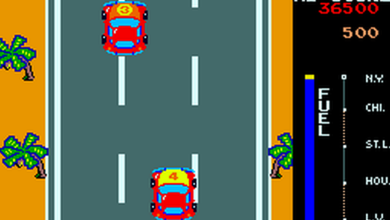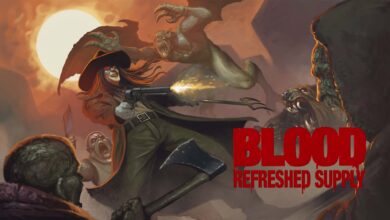I was attacked by an Owl Bear and from then it was Phantasy Star all the way. Owl Bear, looks like neither Owl, nor Bear. Growing up in the era of 8-bit gaming we were spoilt for choice for games to play.
Article by RetroSoops. Follow RetroSoops here: @RetroSoops
A plethora of arcade conversions filled our console and computer shelves. That love of the arcade at home pushed me from the NES to SEGA consoles in a delicate negotiated change of allegiance in the schoolyard. While there has been many a page written on the factions of Nintendo and SEGA with their spirited generals Mario and Sonic, there was one big question that I asked, Final Fantasy or Phantasy Star?
I remember telling a friend of mine about Phantasy Star in the playground, a blank look returned with a pause, and then “You idiot, its Final Fantasy.” The marketing department of Sega clearly hadn’t been doing their work but through some luck I began falling for the series, in a non-canonical order. However on my full play through of all the console games back-to-back a few years ago I started at the beginning. It is only then I appreciated the reform and perfection that was achieved by this wonderful series. Scum! Phantasy Star for the SEGA Master System was released in 1987, or 1988 in the west. It starts on the planet Palma, and one for the first screens that comes up is the state’s police leaving Alis’ brother Nero beaten and battered on the ground.
The heavy political overtones of a futuristic world screaming out for rescue along with a quintessential sound track familiar to a scifi fan of the late 80s is enough to hook anyone. What was so fundamentally different at the time was not just the pace and scale of the world but also the protagonist being a woman. While Samus from Metroid gets much attention for being a stand out figure for equality in games, Alis deserves to share that title as she broke the trend from a lone male on the search to rescue a helpless woman. No Alis didn’t need rescuing, she was determined to do the rescuing herself! Alis is later joined by companions who are determined to free the Algol system from its control at the hands of the evil Darkfalz.
The gameplay that remains a staple for the 8-16-Bit titles of the series features overhead exploration with turn based combat. The unique aspect of the original title however featured trap and monster ridden 3D dungeons. The stand out aspects however which made Phantasy Star on Master System such a groundbreaking title is it’s length, openness, save state option on the cart and the ability to play on the go. The Sega Game Gear released between 1990 and 1992 also had the release of the Master Gear Converter, making all your Master System games playable on the run. Sure the battery life was poor but with a power cable there was now no need to take up the TV when your Dad insisted falling asleep while the cricket was on!
So while Pokemon receives a great deal of respect for bringing such an immersive mobile game, the ability for playing Phantasy Star on the move, in glorious color, was possible a whole four years earlier. A battery drain but worth the cost to play Phantasy Star on the move. There were also a number of Japanese only releases on Game Gear including Phantasy Star Gaiden, where Alis is recalled to re-battle evil and Phantasy Star Adventure an investigation text based adventure that takes place at the same time as Phantasy Star II. The transition to the 16-Bit era in my neighborhood and group of friends was dominated by two words…. Mega Drive.
It would be literally years after that I met someone who owned a Super Nintendo and the video shops of the small community I lived in were lined with SEGA titles. One of these was the follow up of the series Phantasy Star II. Much like the Mega Drive transition from Master System the game was prettier, bigger, had an upbeat soundtrack and pushed the boundaries further. The protagonist Rolf lives a millennia after the first title series. The nod to the Orwellian futuristic scenarios intertwines in the story with the computer network of Mother Brain affected by malfunctions endangering the life of those in the newly geo-engineered Motavia.
Rolf switches sides to battle not only the controlling Mother Brain but also the returned Dark Force, the enemy that Aris killed in the first title. Bye, need to go rescue the universe! The follow up of Phantasy Star III: Generations of Doom was the first of the series to span over three generations. You play Rhys a member of one of the game’s factions the Orakians and get to choose which of the women you encountered to marry and then have children with thus choosing the next protagonist of the following generation. It can be heartbreaking saying goodbye to a character you’ve developed so much energy into in any game, yet with the continuing of the generations in this title you genuinely miss those older generations that span the storyline.
The game however leaves the familiar star system behind yet the feeling of the title still remains resoundingly ‘Phantasy Star-esque’. Yes I will take you as my wife, as soon as I rescue you from impending doom! Coming at the end of the life of the Mega Drive the farewell to the 16-Bit era is given a wonderful send off by Phantasy Star IV: The End of the Millennium. Returning to Algol System the game starts a millennia after the events of Phantasy Star II. The reform of this title was the first in introducing programmable macros to let off series of attacks. You play as Alys and Chaz who are hunters, and fight off the return of the pesky enemy Dark Force.
The battle continues past Dark Force with you finally facing the core of evil, the Profound Darkness, who is the final boss of the series. The influence of this title on the later Phantasy Star Online series can be seen looking back through the past and it remains an absolute classic of the Mega Drive library. The End of the Millennium, the perfect send off! A number of compilations have been released of the series including a GameBoy port, which goes through games 1-3. The SEGA Ages 2500 series on PlayStation 2 released in Japan saw the release of glamorized and reinvented versions of game 1 and 2, expanding on the backstory, combat and graphics. Sadly these versions failed to receive an English release.
The original four titles are however available on Virtual Console for the Nintendo Wii and they all feature in the Sega Mega Drive Ultimate Collection, or Sonic’s Ultimate Genesis Collection in the US, for the PlayStation 3 and Xbox 360
The collection goes for a bargain now days and it is your best option for playing the titles affordably. A beautiful remake sadly never getting the English treatment. Thus ended the original series and sadly the SEGA Saturn was only home to a compilation released in Japan with the series left to rest until Dreamcast era. At this point again the series pushed the limits and brought about innovation. That however is a story for another day.
Article by RetroSoops. Follow RetroSoops here: @RetroSoops








